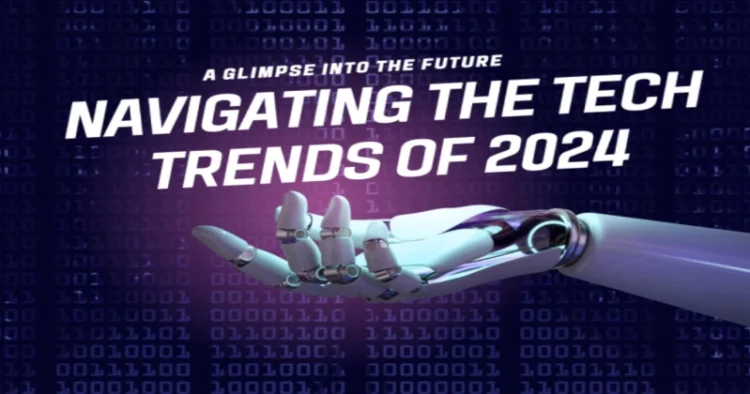As we embark on our exploration, let’s dive into the dynamic intersection of emerging technologies and their far-reaching impact across diverse industries. From healthcare to finance, manufacturing to entertainment, these trends are shaping the future landscape. Buckle up as we navigate the exciting terrain where innovation meets practical application, uncovering how these transformative technologies are revolutionizing the way we live, work, and thrive. Now, let’s delve into the notable trends and their impact across various industries, aligned with the emerging technologies in 2024 and beyond-
1) Smart World
- AI Avatars: These human-like virtual personas created using AI techniques are revolutionizing customer interactions in sectors like retail, entertainment, and customer service. Imagine personalized AI avatars assisting shoppers or enhancing gaming experiences.
- Digital Twins: Industries such as manufacturing, energy, and healthcare leverage digital twins to simulate real-world scenarios, optimize processes, and predict maintenance needs.
- Multimodal User Interfaces: Expect advancements in automotive, wearables, and smart home devices, where seamless interactions between users and machines occur simultaneously.
- Smart Spaces: These intelligent ecosystems impact real estate, urban planning, and facility management, enhancing efficiency and user experiences.
- Spatial Computing: Combining physical and digital elements, spatial computing influences architecture, design, and education.
2) Productivity Revolution
- GenAI: Its widespread adoption across enterprises is driving productivity improvements in various sectors.
- Model Compression: In edge computing, smaller neural networks enable efficient deployment on devices and systems.
- Autonomous Unmanned Aerial Vehicles (UAVs): These are transforming logistics, agriculture, and infrastructure inspection.
- GenAI-Enabled Virtual Assistants (VAs): Enhanced by large language models, they assist users in healthcare, finance, and customer support.
3) Privacy and Transparency
- Blockchain: Beyond cryptocurrencies, blockchain ensures secure and transparent transactions in finance, supply chain, and identity management
- Privacy-Preserving AI: Industries handling sensitive data, such as healthcare and finance, are adopting privacy-enhancing AI techniques.
4) Critical Enablers
- Quantum Computing: While not yet mainstream, quantum computing research impacts fields like pharmaceuticals, materials science, and finance.
- Edge Computing: Its adoption accelerates in manufacturing, IoT, and smart cities, reducing latency and improving real-time decision-making.
Now, let’s embark on a journey through the ever-evolving landscape of emerging technologies and their profound impact on diverse industries. From healthcare to manufacturing, finance to entertainment, these cutting-edge innovations are reshaping the way we live, work, and interact. In this exploration, we’ll delve into specific examples that showcase how technologies like AI, quantum computing, robotics, and more are revolutionizing our world. So, fasten your seatbelts as we navigate the intersection of innovation and industry.
Now let’s explore how emerging technologies are impacting various industries, along with specific examples
1) Heavy Industries
These industries deal with large machinery and equipment. Here’s how emerging tech influences them
- 3D Printing: In heavy manufacturing, 3D printing revolutionizes prototyping, spare parts production, and customization. For instance, General Electric uses 3D printing to create complex turbine components for aircraft engines
- Cloud Computing: Heavy industries leverage cloud platforms for data storage, collaboration, and real-time analytics. Caterpillar, a construction equipment manufacturer, uses cloud-based telematics to monitor machine performance and predict maintenance needs
- AI in Supply Chain: AI algorithms optimize supply chain logistics, reducing costs and improving efficiency. Companies like Maersk, a shipping giant, use AI to optimize container routing and minimize fuel consumption
2) Process Industries
These sectors include chemicals, food, and pharmaceuticals. Key trends and examples
- Artificial Intelligence (AI) and Machine Learning (ML): Drug discovery and quality control benefit from AI and ML. Novartis, a pharmaceutical company, uses ML models to predict drug interactions and optimize clinical trials
- Nanotechnology: Process industries utilize nanomaterials for high-performance coatings, drug delivery, and water purification. BASF develops nanocomposites for lightweight automotive parts
- IoT in Food Safety: Sensors and IoT devices monitor food storage conditions, ensuring safety and reducing waste. Nestlé uses IoT sensors to track freshness and quality throughout the supply chain.
3) Light Industries
These areas include electronics, apparel, and consumer goods. Notable trends and use cases
- AI in Trend Forecasting: Retailers like Zara use AI algorithms to predict fashion trends, optimize inventory, and personalize recommendations
- Connected Clothing: Wearables embedded with sensors enhance user experiences. Under Armour integrates fitness trackers into athletic apparel
- Smart Homes: IoT devices in light industries enable energy efficiency, security, and convenience. Google Nest offers smart thermostats and home automation solutions
- 3D Printing for Rapid Prototyping: Companies like Nike use 3D printing to create prototypes for shoe designs, reducing lead time and costs
4) Service Industries
These sectors encompass finance, healthcare, and more. Noteworthy trends and applications
- Blockchain in Finance: Decentralised finance (DeFi) platforms like Compound use blockchain for transparent lending and borrowing
- Healthcare AI: AI assists in medical diagnosis, personalized treatment plans, and drug discovery. IBM Watson Health analyzes patient data to recommend treatment options
- Telehealth: Virtual consultations and remote patient monitoring are on the rise. Teladoc Health provides telehealth services globally
5) The ‘Outliers’
Some industries don’t fit neatly into predefined categories but play vital roles globally
- Agriculture: Precision agriculture uses IoT sensors, drones, and AI for crop monitoring, irrigation, and yield optimization. John Deere implements precision farming techniques.
- Packaging: Sustainable packaging solutions, such as biodegradable materials and smart labels, impact the environment. Amcor develops recyclable packaging solutions.
Now, let’s briefly look separately into distinct industries
Healthcare
- AI-driven diagnostics and personalized medicine
- Telehealth and remote patient monitoring
Finance
- Blockchain for secure transactions and decentralized finance (DeFi)
- AI-powered fraud detection and risk assessment
Manufacturing
- 3D printing for rapid prototyping and customized production
- AI-driven predictive maintenance
Retail and E-Commerce
- AR/VR for immersive shopping experiences
- AI-powered recommendation engines
Energy and Environment
- Cleantech innovations for renewable energy and emissions reduction
- IoT-enabled smart grids and energy management
Transportation and Logistics
- Autonomous vehicles and drones
- Blockchain-based supply chain tracking
Education and Training
- AR/VR for interactive learning
- AI-driven personalized education paths
Remember, these trends are dynamic, and these examples showcase how emerging technologies are transforming industries, driving innovation, and shaping our future. Organizations that embrace these technologies strategically will thrive in the evolving landscape! 🌟
As we conclude our exploration of emerging technologies and their impact on various industries, we find ourselves at the crossroads of innovation and possibility. From healthcare to finance, manufacturing to entertainment, these trends are shaping the future landscape. And from the precision of advanced robotics to the quantum leaps of AI, our world is undergoing a transformation fueled by creativity, collaboration, and curiosity. As these technologies continue to evolve, they empower us to solve complex problems, enhance our lives, and shape a brighter future. Buckle up as we navigate the exciting terrain where innovation meets practical application, uncovering how these transformative technologies are revolutionizing the way we live, work, and thrive. So, let’s embrace the journey ahead, where the intersection of technology and human ingenuity knows no bounds. 🌟




















Comments